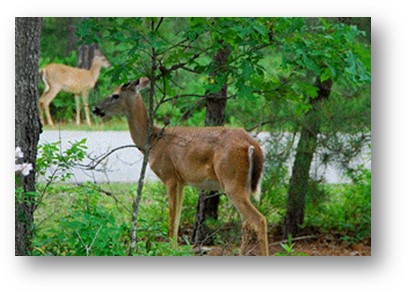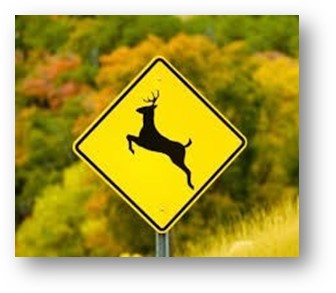DEP, NJDOT Remind Drivers to Be Extra Cautious as Deer Mating Season Begins, Daylight Hours Get Shorter (20/P044)
(20/P044) TRENTON – As deer mating season is approaching and daylight savings is underway, the New Jersey Department of Environmental Protection’s Division of Fish and Wildlife and the New Jersey Department of Transportation are reminding motorists to drive with extra caution and watch for white-tailed deer.
Deer are more likely to suddenly run onto roadways during this time of year – known as the fall rut -- as bucks pursue does, risking the possibility of colliding with a vehicle. Increased deer activity is more likely to occur in the early morning and around sunset, when visibility may be difficult.
 “Deer are involved in thousands of collisions with motor vehicles in New Jersey each year, with the highest number occurring during the fall mating season,” Division of Fish and Wildlife Director Dave Golden said. “We urge all drivers to be especially alert to the possibility of deer suddenly darting onto roadways and to be aware of things they can do to reduce the risk of a collision and possible serious injury to themselves or their passengers.”
“Deer are involved in thousands of collisions with motor vehicles in New Jersey each year, with the highest number occurring during the fall mating season,” Division of Fish and Wildlife Director Dave Golden said. “We urge all drivers to be especially alert to the possibility of deer suddenly darting onto roadways and to be aware of things they can do to reduce the risk of a collision and possible serious injury to themselves or their passengers.”
Peak mating season for deer in New Jersey runs from late October throughout November and into mid-December in all areas of the state.
Being extra vigilant for deer will become even more important when daylight saving time ends at 2:00 a.m. on Sunday, Nov. 1. Many commutes will then align with the periods when deer are most active, and lighting conditions may be the most difficult for driving.
Reduced lighting as well as sun glare can make it very difficult for drivers to see deer that are about to cross the road. In addition, multiple deer may cross the road at any moment, usually in single file.
These tips can help motorists stay safe during the fall rut:

For more information about white-tailed deer in New Jersey, visit www.njfishandwildlife.com/deer.htm.
Like the Division of Fish and Wildlife’s Facebook page at www.facebook.com/NJFishandWildlife/.
Follow the Division of Fish and Wildlife on Instagram @newjerseyfishandwildlife.
Follow the DEP on Twitter @NewJerseyDEP.
Motorists are encouraged to check NJDOT’s traffic information website www.511nj.org for real-time travel information.
For NJDOT news follow us on Twitter @NJDOT_info or on the NJDOT Facebook page.
###
